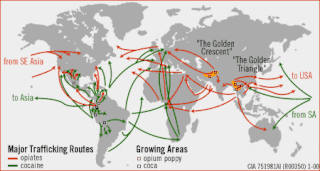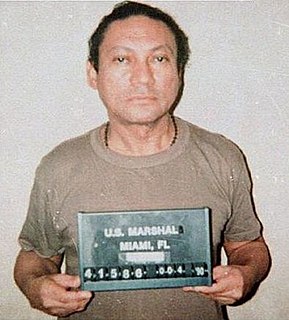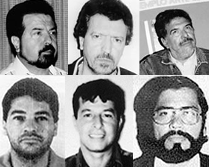Related Research Articles

The illegal drug trade or drug trafficking is a global black market dedicated to the cultivation, manufacture, distribution and sale of prohibited drugs. Most jurisdictions prohibit trade, except under license, of many types of drugs through the use of drug prohibition laws. The think tank Global Financial Integrity's Transnational Crime and the Developing World report estimates the size of the global illicit drug market between US$426 and US$652 billion in 2014 alone. With a world GDP of US$78 trillion in the same year, the illegal drug trade may be estimated as nearly 1% of total global trade. Consumption of illegal drugs is widespread globally and it remains very difficult for local authorities to thwart its popularity.

The Medellín Cartel was a powerful and highly organized Colombian drug cartel and terrorist organization originating in the city of Medellín, Colombia that was founded and led by Pablo Escobar. It is often considered the first major “drug cartel” and was referred to as such due to the organization's upper echelons being built on a partnership between multiple Colombian traffickers operating alongside Escobar. Included were Jorge Luis Ochoa Vásquez, Juan David Ochoa Vásquez, José Gonzalo Rodríguez Gacha and Carlos Lehder. The cartel operated from 1972 to 1993 in Bolivia, Colombia, Panama, Central America, Peru, the Bahamas, the United States, as well as in Canada. Although the organization started out as a smuggling network in the early 1970s, it wasn't until 1976 that the organization turned to trafficking cocaine. This was a result of Escobar getting introduced to the lucrative idea of cocaine smuggling by fellow Colombian trafficker Griselda Blanco. At the height of its operations, the Medellín Cartel smuggled multiple tons of cocaine each week into countries around the world and brought in up to US$60 million daily in drug profits.

Narco-state is a political and economic term applied to countries where all legitimate institutions become penetrated by the power and wealth of the illegal drug trade. The term was first used to describe Bolivia following the 1980 coup of Luis García Meza which was seen to be primarily financed with the help of narcotics traffickers. Other well-known examples are Honduras, Guinea-Bissau, Afghanistan, Mexico, Myanmar and Syria, where drug cartels produce, ship and sell drugs such as captagon, cocaine and marijuana.
Joseph-Michel François was a colonel in the Haitian army. As Haiti Chief of National Police he participated in the 1991 Haitian coup d'état, which overthrew Haiti's elected president, Jean-Bertrand Aristide. Former Haitian President candidate Michel "Sweet Mickey" Martelly is known to have associated with François.

The United States Central Intelligence Agency (CIA) has been accused of involvement in drug trafficking. Books and investigations on the subject that have received general notice include works by the historian Alfred McCoy, professor and diplomat Peter Dale Scott, journalists Gary Webb and Alexander Cockburn, and writer Larry Collins. These claims have led to investigations by the United States government, including hearings and reports by the United States House of Representatives, Senate, Department of Justice, and the CIA's Office of the Inspector General.

The Kerry Committee report, formally titled Drugs, Law Enforcement and Foreign Policy, was the final report of an investigation by the Senate Foreign Relations Committee's Subcommittee on Terrorism, Narcotics, and International Operations. The report examined the problems that drug cartels and drug money laundering in South and Central America and the Caribbean posed for American law enforcement and foreign policy. The Sub-Committee was chaired at the time by Democratic Party Senator John Kerry from Massachusetts, so that the report is often referred to under his name.

A number of writers have alleged that the United States Central Intelligence Agency (CIA) was involved in the Nicaraguan Contras' cocaine trafficking operations during the 1980s Nicaraguan civil war. These claims have led to investigations by the United States government, including hearings and reports by the United States House of Representatives, Senate, Department of Justice, and the CIA's Office of the Inspector General which ultimately concluded the allegations were unsupported. The subject remains controversial.

The illegal drug trade in Colombia has, since the 1970s, centered successively on four major drug trafficking cartels: Medellín, Cali, Norte del Valle, and North Coast, as well as several bandas criminales, or BACRIMs. The trade eventually created a new social class and influenced several aspects of Colombian culture and politics.
This article deals with activities of the U.S. Central Intelligence Agency related to transnational crime, including the illicit drug trade.
The Central Intelligence Agency focuses on fighting two major conflicts, the cultivation and trafficking of cocaine and the local extremist groups in Colombia. The Revolutionary Armed Forces of Colombia (FARC) is one of the main extremist groups in Colombia. The CIA activities revolve heavily around stopping the production of cocaine, and stopping the FARC.
A drug lord, drug baron, kingpin or narcotrafficker is a high ranking crime boss who controls a sizable network of people involved in the illegal drug trade. Such figures are often difficult to bring to justice, as they are normally not directly in possession of something illegal, but are insulated from the actual trade in drugs by several layers of staff. The prosecution of drug lords is therefore usually the result of carefully planned infiltration into their networks, often using informants from within the organizations.
Crime in Haiti is investigated by the Haitian police.
Illegal drug trade in Venezuela is the practice of illegal drug trading in Venezuela. Venezuela has been a path to the United States for illegal drugs originating in Colombia, through Central America and Mexico and Caribbean countries such as Haiti, the Dominican Republic, and Puerto Rico.
The illegal drug trade in Guatemala includes trans-shipment of cocaine to the United States. According to some reports, Mexican drug cartels such as Sinaloa have also established poppy growing operations there. There is a reported relationship between the Mexican Los Zetas cartel and the Guatemalan Kaibiles military force.
The illegal drug trade in Panama includes trans-shipment of cocaine to the United States. The 1989 United States invasion of Panama to topple Dictator Manuel Noriega was justified in part by the need to combat drug trafficking. Noriega, the dictator of Panama from 1983 to 1989, had a relationship with the U.S. Central Intelligence Agency (CIA) from the 1950s. More recently, Mexican cartels such as the Sinaloa Cartel have been active in Panama.

The illegal drug trade in Latin America concerns primarily the production and sale of cocaine and cannabis, including the export of these banned substances to the United States and Europe. The Coca cultivation is concentrated in the Andes of South America, particularly in Colombia, Peru and Bolivia; this is the world's only source region for coca.

Drug barons of Colombia refer to some of the most notable drug lords which operate in illegal drug trafficking in Colombia. Several of them, notably Pablo Escobar, were long considered among the world's most dangerous and most wanted men by U.S. intelligence. "Ruthless and immensely powerful", several political leaders, such as President Virgilio Barco Vargas, became convinced that the drug lords were becoming so powerful that they could oust the formal government and run the country.
La Corporación, also known as the Santa Ana Cartel, was a Bolivian drug cartel and criminal organization, headed in the 1970s and 1980s by notorious drug lord Roberto Suárez Goméz, known as the "King of Cocaine".
The Miami drug war was a series of armed conflicts in the 1970s and 1980s, centered in the Florida city of Miami, between the United States government and multiple drug cartels, primarily the Medellín Cartel. It was predominantly fueled by the illegal trafficking of cocaine.

The cocaine boom was a stark increase in the illegal production and trade of Cocaine that developed in the 1970s and peaked in the 1980s. The boom was the result of organized smugglers who imported cocaine from Latin America to the United States, and a rising demand in cocaine due to cultural trends in the United States. Smuggling rings of Cuban exiles organized trade networks from Latin America to Miami that streamlined the import of cocaine to the United States. Americans also began favoring less the drugs popular in the 60s counterculture such as marijuana and LSD, and instead began to prefer cocaine due to a mystique of prestige that was developing around it. This increase in cocaine trade fueled the rise of the crack epidemic and government sponsored anti-drug campaigns.
References
- ↑ Haiti: Drug Trafficking Crossroads
- ↑ United States Institute of Peace, June 2007, Haiti's Drug Problem Archived 2010-08-05 at the Wayback Machine
- 1 2 3 4 Whitney, Kathleen Marie (1996), "Sin, Fraph, and the CIA: U.S. Covert Action in Haiti", Southwestern Journal of Law and Trade in the Americas, Vol. 3, Issue 2 (1996), pp. 303-332
- 1 2 Ivelaw L. Griffith. Drugs and Security in the Caribbean: Sovereignty under Siege. (University Park, PA: Pennsylvania State University Press, 1997.), p. 74
- 1 2 New York Times , 22 April 1994, Colombian Drug Trafficker Implicates Haitian Police Chief
- ↑ Stotzky (1997:175)
- ↑ Irwin P. Stotzky. Silencing the Guns in Haiti: The Promise of Deliberative Democracy., Chicago, IL: The University of Chicago Press, 1997. p. 176
